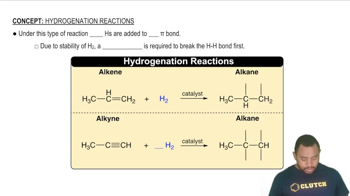Suppose you have two colorless molecular liquids, one boiling at - 84 °C, the other at 34 °C, and both at atmospheric 6 pressure. Which of the following statements is correct? For each statement that is not correct, modify the statement so that it is correct. (e) At - 84 °C both liquids have vapor pressures of 760 mm Hg.
Ch.11 - Liquids and Intermolecular Forces
Chapter 11, Problem 80e
The table below shows the normal boiling points of benzene and benzene derivatives. (e) Why is the boiling point of phenol the highest of all?
 Verified step by step guidance
Verified step by step guidance1
Identify the compounds in the table: benzene and its derivatives, including phenol.
Understand that boiling point is influenced by intermolecular forces: stronger forces lead to higher boiling points.
Recognize that phenol has an -OH group, which allows for hydrogen bonding, a strong intermolecular force.
Compare the intermolecular forces: phenol's hydrogen bonding is stronger than the van der Waals forces in benzene and other derivatives without -OH groups.
Conclude that the presence of hydrogen bonding in phenol results in a higher boiling point compared to other benzene derivatives.

Verified video answer for a similar problem:
This video solution was recommended by our tutors as helpful for the problem above.
Video duration:
44sWas this helpful?
Key Concepts
Here are the essential concepts you must grasp in order to answer the question correctly.
Hydrogen Bonding
Hydrogen bonding is a strong type of dipole-dipole interaction that occurs when hydrogen is bonded to highly electronegative atoms like oxygen or nitrogen. In phenol, the hydroxyl (-OH) group can form hydrogen bonds with other phenol molecules, leading to increased intermolecular attractions. This results in a higher boiling point compared to compounds that do not exhibit hydrogen bonding.
Recommended video:
Guided course

Hydrogenation Reactions
Intermolecular Forces
Intermolecular forces are the forces of attraction or repulsion between molecules. They include hydrogen bonds, dipole-dipole interactions, and London dispersion forces. The strength and type of these forces significantly influence the physical properties of substances, such as boiling points. Phenol's ability to engage in strong hydrogen bonding elevates its boiling point relative to other benzene derivatives.
Recommended video:
Guided course

Intermolecular vs Intramolecular Forces
Molecular Structure and Polarity
The molecular structure and polarity of a compound play crucial roles in determining its boiling point. Phenol has a polar -OH group, which contributes to its overall polarity. This polarity enhances the strength of intermolecular forces, particularly hydrogen bonding, making phenol's boiling point higher than that of non-polar or less polar benzene derivatives.
Recommended video:
Guided course

Molecular Polarity
Related Practice
Textbook Question
Textbook Question
Two isomers of the planar compound 1,2-dichloroethylene are shown here.
(a) Which of the two isomers will have the stronger dipole– dipole forces?
Textbook Question
The table below shows the normal boiling points of benzene and benzene derivatives.
(a) How many of these compounds exhibit dispersion interactions?
Textbook Question
Use the normal boiling points propane (C3H8) -42.1 °C butane (C4H10) -0.5 °C pentane (C5H12) 36.1 °C hexane (C6H14) 68.7 °C heptane (C7H16) 98.4 °C to estimate the normal boiling point of octane (C8H18). Explain the trend in the boiling points.
Textbook Question
(a) When you exercise vigorously, you sweat. How does this help your body cool?
